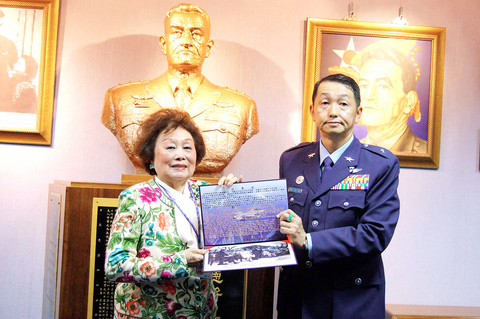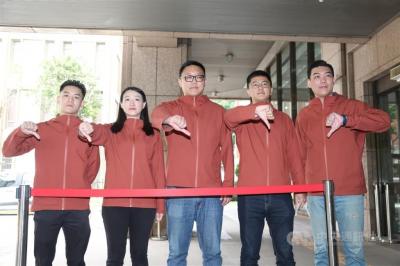Sixty-five years ago, a group of young Americans boarded a Dutch packet and crossed the Pacific at the invitation of Madame Chiang Kai-shek. Their passports identified them simply as teachers or farmers. If asked at the time, "Why in God's name are you going to the Orient amid World War II?" they probably would have responded, "For sightseeing, of course."
But these were no tourists. They were members of the American Volunteer Group (AVG) -- better known as the "Flying Tigers" -- a top-secret fighter unit that picked dogfights with Japanese planes in the skies over China and Southeast Asia in 1941 and 1942.
"The experts said the AVG wouldn't last three weeks against the Japanese, as its Air Force enjoyed numerical superiority in the Pacific theater," said Jon Pensyl, 81, a former AVG member. "Well, we smashed the Japanese Air Force over China for over seven months, keeping their bombers away from strategic points in that country."

PHOTO: HUA MENG-JIN, TAIPEI TIMES
Pensyl, Director of the 5th Fighter Group Association -- a club comprised of former AVG pilots and ground crew -- was back in the Pacific theater yesterday, along with his comrades in arms, to attend a ceremony at the Hualien Air Force Base honoring General Claire Chennault, the founder of the AVG.
Chennault's group was a force to be reckoned with, achieving a kill ratio of 15:1 -- or 15 Japanese aircraft shot down for every one Flying Tiger P-40 fighter plane -- in the skies over what was then Burma. Nowadays, Chennault and his Flying Tigers are a potent symbol of the friendship between the US and Taiwan.
FRIEND OF `FREE CHINA'

PHOTO: YU TAI-LAN, TAIPEI TIMES
Once a captain in the US Army Air Corps, Chennault left his post in 1937, traveling to China at the behest of the Chinese Nationalist Army (KMT) to help overhaul the Chinese Air Force. Two years later, "the Japanese began to break the back of the Chinese resistance by sustained bombing of every major population center in Free China," the Flying Tigers' official Web site states.
In the face of that withering Japanese bombing campaign, Chennault scrambled to lobby Washington to give him planes and pilots, which he finally received in the summer of 1941. The US fighter contingent was officially a part of the Chinese Air Force, but was commanded by Chennault. He trained the pilots in Rangoon, eventually moving the unit to China, where it fought pitched battles against Japanese fighters and bombers.
ENDURING TIES
That the US contributed scores of talented men and first-class planes to the Republic of China's (ROC) Air Force reveals as much about its trust of, and friendship with, Taiwan as its determination to defeat Japan in World War II.
It was that American spirit of friendship and sacrifice that led Major General Mike Tien (
"We were recently awarded a grant worth US$100,000 to renovate an already existing museum [on the base], and I wished to recreate it as a memorial to General Chennault," Tien said.
On July 19, with the approval of the Taipei City Government, a bronze bust of Chennault was relocated from a Taipei park to the 401st TCW Museum, which was officially opened to the public yesterday amid much fanfare.
"General Chennault's statue is home now," Tien announced, misty-eyed, at a ribbon-cutting ceremony at the museum. "[The 401st TCW] will take care of him now."
The ceremony was attended by Chennault's wife, Anna Chan Chennault (
"When Claire Chennault first came to China [in the 1930s], I was only in the third grade," Chennault said.
The two first met in China in 1945, when Mrs. Chennault was a 20-year-old reporter for the Central News Agency and Chennault was a dashing US commander in his 50s helping China to fight the Japanese. She said they were taken with each other from their first meeting, despite their age difference. They were married soon after their first encounter, but Chennault died of lung cancer just a decade later, widowing Anna with two children.
Mrs. Chennault quickly became popular in Washington's social circles, charming Presidents Kennedy, Johnson, Nixon, Ford, Carter, and Reagan, according to her autobiography The Education of Anna.
Under President Kennedy, she became the first Chinese-American person to work in the White House. She served as chairwoman of the Chinese Refugees Relief Committee and later earned a reputation as a "secret ambassador" of the US seeking to broker cross-strait reconciliation.
She was also the inheritor of an airline that Chennault had founded in the Asia-Pacific region; she was forced to sell it to the CIA after Chennault's death to fend off insolvency, according to her book. The airline eventually became "Air America," the CIA's private fleet of cargo planes.
In spite of a few cloak-and-dagger legends, however, Mrs. Chennault's life story is overwhelmingly about charity and honoring her husband. Her humility and graciousness were on full display yesterday, as she joined the Taiwanese Air Force in paying tribute to Chennault and his storied Flying Tigers.
She was not alone.
"General Chennault just gave off an aura of leadership," said James Bennie, 84, an American fighter plane mechanic who served under Chennault. "He was a man who instinctively knew how to lead."
Harold Javitt, a former P-40 fighter pilot who destroyed "quite a number [of Japanese planes] on the ground," and who also served under Chennault, praised his commander as a "great and approachable leader" who would play baseball with his men during downtime.
Other US dignitaries in attendance included American Institute in Taiwan (AIT) Liaison Affairs Chief Albert Willner.
"It's great for us to be representing veterans on both sides," Willner said, emphasizing the spirit of cooperation that the US and Taiwan have enjoyed since the Flying Tigers first graced the skies over Asia.
Pensyl concluded a tour of the museum by donating his original leather aviator jacket, complete with "blood chit," to the museum. Blood chits are square fabric linings of Flying Tigers' jackets, identifying the pilots in Chinese as "foreigners who have come to China to help it wage war against the Japanese."
An additional inscription asks in Chinese to help aid and protect the wearer.
DAZZLING DISPLAY
The ceremony was topped off with an F-16 air show that dazzled thousands of spectators: Jet fighters roared through the sky at Mach 1 against a backdrop of jungle-covered mountains. The old Flying Tigers looked on from their seats, wide-eyed, perhaps reminiscing about their days behind the throttle of the single propeller-driven P-40 with a grinning shark's mouth painted on either side.
Aerial combat has changed considerably since the Flying Tigers' dicey dogfights with the Japanese.
"Nowadays, we don't have to be all that maneuverable [in the F-16] because we have missiles that can destroy an enemy before he can even be seen by the pilot," a Taiwanese F-16 pilot dressed in an orange jumpsuit told the Taipei Times.
Joe Rosbert, a late Flying Tiger who served in Burma, gave a gritty account of some of the Flying Tigers' fights in his book Flying Tiger Joe's Adventure Story Cookbook.
"I was getting my finger set on the gun button when we found ourselves in the midst of a group of [Japanese] fighters flying crazily in a bunch like bees. In a flash, one appeared in my sight at close range; the two ugly red suns on the wings stood out. I managed one quick burst and almost immediately flew through the smoke and pieces that came from the plane. As I dove down and away, I saw him catch fire and spin earthward."
On their way to board the bus back to their hotel, the last of the Flying Tigers looked up at the sky in which aerial combat is now an almost science-fiction affair, with computers doing the aiming, firing and flying.
"I'm not so young anymore, you know," Pensyl said, before his son helped him onto the bus. "I'm 81 -- the others are nearing 90. I think this is my last visit here."

Taiwan is stepping up plans to create self-sufficient supply chains for combat drones and increase foreign orders from the US to counter China’s numerical superiority, a defense official said on Saturday. Commenting on condition of anonymity, the official said the nation’s armed forces are in agreement with US Admiral Samuel Paparo’s assessment that Taiwan’s military must be prepared to turn the nation’s waters into a “hellscape” for the Chinese People’s Liberation Army (PLA). Paparo, the commander of the US Indo-Pacific Command, reiterated the concept during a Congressional hearing in Washington on Wednesday. He first coined the term in a security conference last

Prosecutors today declined to say who was questioned regarding alleged forgery on petitions to recall Democratic Progressive Party (DPP) legislators, after Chinese-language media earlier reported that members of the Chinese Nationalist Party (KMT) Youth League were brought in for questioning. The Ministry of Justice Investigation Bureau confirmed that two people had been questioned, but did not disclose any further information about the ongoing investigation. KMT Youth League members Lee Hsiao-liang (李孝亮) and Liu Szu-yin (劉思吟) — who are leading the effort to recall DPP caucus chief executive Rosalia Wu (吳思瑤) and Legislator Wu Pei-yi (吳沛憶) — both posted on Facebook saying: “I

The Ministry of Economic Affairs has fined Taobao NT$1.2 million (US$36,912) for advertisements that exceed its approved business scope, requiring the Chinese e-commerce platform to make corrections in the first half of this year or its license may be revoked. Lawmakers have called for stricter enforcement of Chinese e-commerce platforms and measures to prevent China from laundering its goods through Taiwan in response to US President Donald Trump’s heavy tariffs on China. The Legislative Yuan’s Finance Committee met today to discuss policies to prevent China from dumping goods in Taiwan, inviting government agencies to report. Democratic Progressive Party Legislator Kuo Kuo-wen (郭國文) said

The Ministry of Economic Affairs has fined Taobao NT$1.2 million (US$36,900) for advertisements that exceeded its approved business scope and ordered the Chinese e-commerce platform to make corrections in the first half of this year or its license would be revoked. Lawmakers have called for stricter supervision of Chinese e-commerce platforms and more stringent measures to prevent China from laundering its goods through Taiwan as US President Donald Trump’s administration cracks down on origin laundering. The legislature’s Finance Committee yesterday met to discuss policies to prevent China from dumping goods in Taiwan, inviting government agencies to report on the matter. Democratic Progressive Party